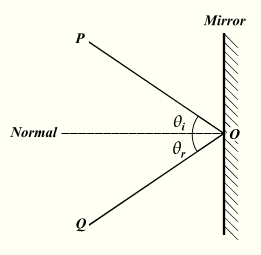Reflection (physics)
|
|
Reflection is the abrupt change in direction of a wave front at an interface between two dissimilar media so that the wave front returns into the medium from which it originated. Common examples include the reflection of light, sound and water waves.
Reflection of light may be specular (that is, mirror-like) or diffuse (that is, not retaining the image, only the energy) depending on the nature of the interface. Whether the interfaces consists of dielectric-conductor or dielectric-dielectric, the phase of the reflected wave may or may not be inverted.
| Contents |
Specular (mirror-like) reflection
A mirror provides the most common model for specular light reflection and consists of a glass sheet in front of a metallic coating where the reflection actually occurs. It is also possible for reflection to occur from the surface of transparent media, such as water or glass.
In the diagram, a light ray PO strikes a vertical mirror at point O, and the reflected ray is OQ. By projecting an imaginary line through point O perpendicular to the mirror, known as the normal, we can measure the angle of incidence, θi and the angle of reflection, θr. The law of reflection states that θi = θr, or in other words, the angle of incidence equals the angle of reflection.
In fact, reflection of light may occur whenever light travels from a medium of a given refractive index into a medium with a different refractive index. In the most general case, a certain fraction of the light is reflected from the interface, and the remainder is refracted. Solving Maxwell's equations for a light ray striking a boundary allows the derivation of the Fresnel equations, which can be used to predict how much of the light is reflected, and how much is refracted in a given situation. Total internal reflection of light from a denser medium occurs if the angle of incidence is above the critical angle.
For parabolic reflection, such as those used in car headlights, see paraboloid.
Other types of reflection
Diffuse reflection
(main article diffuse reflection)
Diffuse_reflection.PNG
Light bounces off in all directions due to the microscopic irregularities of the interface; this is an omnipresent phenomenon, applicable for all non-shiny objects that are not black.
Retroreflection
In a retroreflection, the light bounces back in the direction from which it came.
Neutron reflection
Materials that reflect neutrons, for example beryllium, are used in nuclear reactors and nuclear weapons.
Quantum Interperatation
All interactions between light photons and matter are described as a series of absorption and emission of photons. If one examines a single molecule at the surface of a material, an arriving photon will be absorbed and almost immediately reemitted. The new photon may be emitted in any direction, thus causing diffuse reflection.
The specular reflection (following Hero's equi-angular reflection law) is a quantum effect explained as the sum of the most likely paths the photons will have taken. Light-matter interactions are described in detail by Richard Feynman in his book QED.
As the photon absorbed by the molecule may match energetic levels of the molecule (Kinetic, Rotational, Electronic or Vibrational), the photon may not be reemitted or alternatively may lose some of its energy in the process. The emitted photon will have a slightly different level of energy. These effects are known as Raman, Brillouin and Compton scattering.
See also
- Diffraction
- Reflectivity
- Refraction
- Ripple tank for a picture and description of water waves reflecting off a boundary.
- Snell's law
- Echo satellite
- Anti-reflective coatingda:Refleksion (fysik)
de:Reflexion (Physik) fr:Réflexion des ondes pl:Odbicie (fizyka) pt:Reflexão sl:odboj zh:反射


